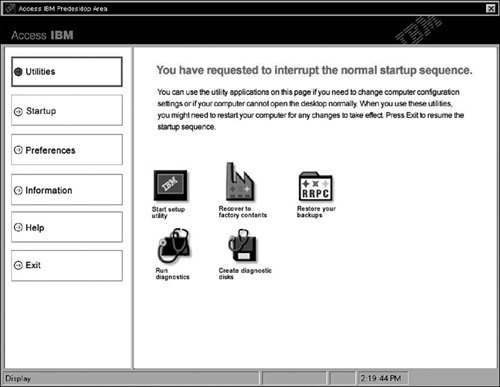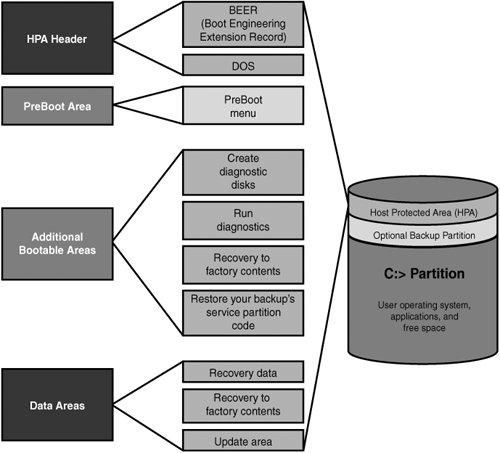Preboot Environment
| The Phoenix FirstBIOS preboot environment has a graphical user interface that allows a user to access the BIOS Setup, extended diagnostics, a backup/restore application, or a full recovery of the original system contents (product restoration to factory-delivered contents). All these applications (except the BIOS Setup) are stored in the HPA, a hidden area of the hard drive literally situated past the reported end of the drive. The number and type of applications accessible via the preboot environment depend on which options the OEM selected when designing the system. Figure 5.9 shows IBM's implementation of the FirstBIOS preboot environment. This environment is activated by pressing the Enter key on the keyboard during the POST. Figure 5.9. IBM's implementation of the FirstBIOS preboot environment. A graphical preboot environment is especially useful for product recovery. For example, most of the larger system OEMs do a lot more than just install Windows on a system before they deliver it. After installing Windows, they install all the service packs and updates available at the time, as well as all the updated drivers unique to their systems. Then they add customizations, such as special wallpapers or interface customizations, support contact information, online system documentation, and custom utilities designed to make their systems easier to use. Finally, they install applications such as DVD players, Office applications or other productivity software, and more. This OEM customization represents a lot of work if a user were to have to duplicate this from scratch, so most manufacturers like to include the ability to easily recover the system to the factory-delivered contents, including the OS, drivers, application, and custom configuration. This is normally provided via several CDs, which could be lost or damaged by the user, are sometimes problematic to use, and which cost money to produce and deliver with the system. By using a BIOS such as the Phoenix FirstBIOS, an OEM can instead deliver the contents of the recovery CDs directly on the hard disk and make it accessible via the preboot menu in the BIOS. Originally, this was done using a hidden partition, which unfortunately could easily be damaged or overwritten by partitioning software or other utilities. In many newer systems, the contents of the recovery CDs is instead preinstalled in the HPA, which is accessible via Protected Area Run Time Interface Extension Services (PARTIES), a standard supported on all ATA-4 or newer drives. HPA/PARTIES works by using the ATA SET MAX ADDRESS command to essentially make the drive appear to the system as a slightly smaller drive. Most manufacturers use the last 3GB of the drive for the HPA. Anything from the new max address (the newly reported end of the drive) to the true end of the drive is considered the HPA and is accessible only using PARTIES commands. Figure 5.10 shows the contents of the HPA and the relationship between the HPA and the rest of the drive. Figure 5.10. The HPA. The HPA is more secure than a hidden partition because any data past the end of the drive simply cannot be seen by any normal application, or even a partitioning utility such as Partition Magic or Partition Commander. This makes it far more secure and immune to damage. Still, if you wanted to remove the HPA, there is a way to reset the max address, thus exposing the HPA. Then you could run something like Partition Magic or Partition Commander to resize the main partition to include the extra space that was formerly hidden and unavailable. The only consequence is that you would lose access to the product recovery, diagnostics, and backup applications preloaded by the OEM. For some people, this might be desirable because future product recoveries could still be done via the recovery CDs (not usually shipped with the system anymore, but still available separately either free or for a minimal charge), and true hardware diagnostics can still be run via bootable floppies or CDs. Also, if you are replacing the hard disk, you can temporarily unhide the HPA on the original drive, allowing it to be copied to a new drive. Alternatively, you can use the OEM-supplied recovery CDs to install the HPA on the new drive. Most new systems using Phoenix FirstBIOS come with their recovery software and diagnostics in the HPA because this is part of the new Phoenix FirstBIOS core managed environment (cME), which is used by a large number of OEMs (including IBM) on most desktop and laptop systems built in 2003 or later. |
EAN: 2147483647
Pages: 283